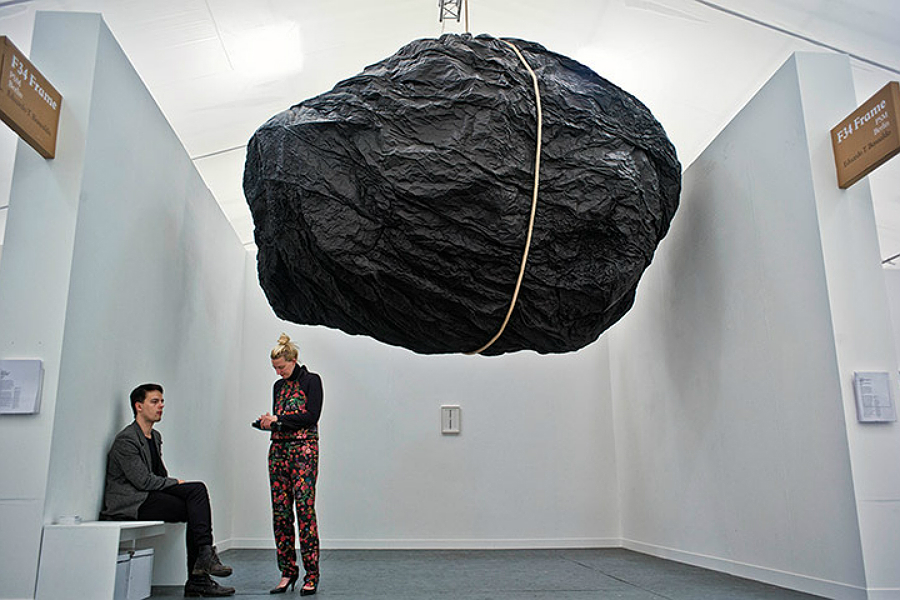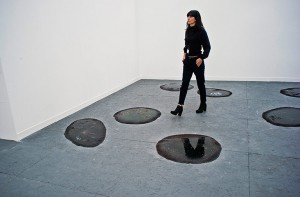Art Fairs: Our Survival Guide

Whether entertainment or strictly business, art fairs can present real opportunities. But where to start? We ask the people who know best…
If you’ve been living on the moon you might not have noticed that the 11th Frieze Art Fair kicked off in London today. But if you’ve never visited an art fair before, what to expect? And if you’re an artist, should you be taking part, and if so, how?
We asked four arts professionals to guide you through the art fair experience. Water bottles and flat shoes at the ready…
The Art Fair Director
Flis Mitchell is co-director of CAVE, an artist-led fair which debuted during last year’s Liverpool Biennial (see our full feature here).
Presenting 45 of the UK’s most exciting unrepresented artists, whilst taking no commission or exhibition fee from those participating, CAVE is pretty much the opposite of what you’d normally expect from a commercial art fair.
“Really good art can be accessible to everyone, it can be completely ambitious, completely critically engaged, difficult and evocative and interesting,” she asserts.
“I love Frieze. It might not be an indicator of great art (although there will be great art there), it’s more of an art supermarket. The whole event is like a vast performance based installation/art comedy, so enjoy it for what for what it is: a spectacle of frantic gallerists, uncomfortable art assistants, the occasional gorgeous booth, strange and awful art made of plastic, and the delicious delight of watching overtired gallerists eject art-touching punters from their booths. Ah schadenfreude.
“My tips for first time Friezers? Take a note pad, collect the cards (someone who might be too busy to talk to you then might be happy to receive an email later), look at the map and be organised. And don’t feel intimidated; it’s an art supermarket – you paid for the ticket, enjoy the show.”
The Gallerist
Ceri Hand is director of a commercial contemporary art gallery based in London, showing up to 10 contemporary art exhibitions per year. The gallery provides emerging and mid-career international artists with opportunities to develop their ideas, commissioning new work on and off-site, attending art fairs, and securing artists opportunities at other galleries. Ceri also offers advice to people wishing to start an art collection.
“Fairs are a great opportunity to see good work by some of the best practitioners today, spot key trends and research galleries,” she reveals.
“The galleries have paid an awful lot of money to be there, representing work of some of their artists in the vague hope they will sell the work and meet new collectors and curators. They are there to promote the work of their artists, so would rather save their voices and patter for seriously interested collectors and curators.

So if you are an artist, and want to take the opportunity to meet gallerists, what approach should you take?
“This is not the time to talk to them about your work or present your portfolio… By all means check them out, see if you like their booth, and their manner with people, and you should get a good sense of whether your work would excite them and whether you are excited by them too. But fair time is expensive, stressful, exhausting, and not the time to introduce yourself unless you have something to offer their artists… So say hello by all means, they will clock you and they will be chuffed and grateful you came to see them on their booth.”
And if you’re a visitor or maybe a future art collector?
“Play the fair game of what you would buy if you have 5k and/or 10k to spend and see how hard the art has to work for you to part with your money! Across London there’s a brilliant range of shows on during Frieze week at major institutions, commercial galleries and artist-run spaces, so if you can, make it a few days’ trip as you will also run into loads of curators and other artists, so a great networking time!”
The Artist
Painter and former gallery director Andrew Foulds was this year an exhibiting artist at Pinta art fair, London, and ran The Royal Standard Gallery’s exhibition at No Soul For Sale art fair, Tate Modern (2010). He has a more tongue-in-cheek view of the experience.
“Frieze is a feeding frenzy and gallerists are like grizzly bears waking up after a long sleep,” he muses. “They generally won’t be interested in talking to a skinny hungry artist because they will be so focused on the fatted calf. This is particularly true of the big chief gallery owners; they’ll be the ones with the cold dead eyes that stare straight through you, but they often have little minion workers who are just desperate to impress and so may talk to you.
“Having had experience behind the scenes at a big art fair, I can say that these events can get incredibly boring for the workers in the stalls and there are always periods in which there is a lull in the flood of visitors. If you time it right you could find yourself in some pleasant and interesting conversations. If you are getting along with someone, it becomes a whole lot easier to approach the subject of your own work.
“Galleries generally have their own particular style, apparent in the work they show, so approach the galleries where you feel your own work would sit comfortably. Practice summarising your own work in one or two memorable sentences, it doesn’t need to be deep, but should capture an essence of what your work is about.
“If you are feeling particularly brazen and a touch immoral you may pretend to be a buyer for a rich client. It’s a good way of finding out about a work you may like, but don’t make any promises or you may find yourself in a bit of debt.”
The Art Fair Addict
Writer and exhibitions co-ordinator Linda Pittwood gets to as many art fairs and festivals as she can, for inspiration, for debate and to discover new artists. “My advice would be, and this is very Frieze specific, don’t bother with talks as they put them online later and you want to dedicate as much time as possible to seeing.
“Do some research so you have some landmarks to aim for. Don’t worry if you come out feeling bewildered, as you will have absorbed more than you think. Don’t feel upset if no one talks to you about the work — that is what museums and galleries are for, whereas the prerogative here is to present and sell.”
The Last Word
Our final advice comes from Ceri Hand. “Wear flat shoes, take an A-Z (as your battery will inevitably die), take some snacks as it’ll be a long day, and try to get to see as many shows as you can alongside the fair.
“And try not to get so drunk you shame yourself so badly you have to move to the Outer Hebrides…”
Laura Robertson





